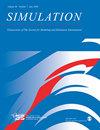V2X-assisted emergency vehicle transit in VANETs
IF 2
4区 工程技术
Q4 COMPUTER SCIENCE, INTERDISCIPLINARY APPLICATIONS
Simulation-Transactions of the Society for Modeling and Simulation International
Pub Date : 2023-11-14
DOI:10.1177/00375497231209774
引用次数: 0
Abstract
Vehicular ad hoc networks (VANETs) can support safety-critical applications such as the safe and fast movement of emergency vehicles while preventing crashes, delays, and congestion involving emergency vehicles. A simulation approach to evaluate ambulance transit using VANET capabilities is presented in this paper for a real-life road network taken in and around the University of Missouri–Kansas City, USA. Three different VANET functional scenarios are compared with a base scenario (SC-1) which depicts the present-day traffic pattern and vehicle behaviors. In the three scenarios, the second one (SC-2) adds vehicle-to-vehicle (V2V) and vehicle-to-infrastructure (V2I) communications along with the present-day traffic pattern; ambulances use VANETs simply to announce their arrival. The third scenario (SC-3) provides functionalities for ambulances to rerouting when they learn about a current or an anticipated road congestion. And the fourth scenario (SC-4) adds vehicle rerouting capabilities, so ambulance routes can be sent to vehicles, and they can avoid the ambulance path. Performance results are presented and evaluated for metrics such as delay, packet drop ratio, the average speed of the ambulance, average vehicle density, and ambulance message interval time. From the simulation results, it was observed that the ambulance transit time reduces by 12.52%, 14.65%, and 18.75% for SC-2, SC-3, and SC-4, respectively, as compared with SC-1, while the average ambulance speed increases by 14.49%, 15.57%, and 20.90% for SC-2, SC-3, and SC-4, respectively, when compared with SC-1. This paper provides substantial evidence that VANET capabilities for emergency vehicles can enhance crash protection and reduce the commute time for emergency response.v2x辅助的VANETs紧急车辆运输
车辆自组织网络(VANETs)可以支持安全关键应用,例如紧急车辆的安全和快速移动,同时防止涉及紧急车辆的碰撞、延误和拥堵。本文介绍了一种使用VANET功能评估救护车运输的模拟方法,该方法适用于美国密苏里-堪萨斯城大学及其周围的现实生活道路网络。三种不同的VANET功能场景与描述当前交通模式和车辆行为的基本场景(SC-1)进行了比较。在这三种方案中,第二种方案(SC-2)在现有交通模式的基础上增加了车对车(V2V)和车对基础设施(V2I)通信;救护车使用vanet只是为了宣布他们的到来。第三种方案(SC-3)为救护车提供了在了解到当前或预期道路拥堵时改变路线的功能。第四种场景(SC-4)增加了车辆重新路由功能,因此救护车路线可以发送给车辆,并且车辆可以避开救护车路径。性能结果呈现和评估指标,如延迟,丢包率,救护车的平均速度,平均车辆密度,和救护车的消息间隔时间。从仿真结果可以看出,SC-2、SC-3和SC-4的救护车通行时间分别比SC-1缩短了12.52%、14.65%和18.75%,而SC-2、SC-3和SC-4的救护车平均速度分别比SC-1提高了14.49%、15.57%和20.90%。本文提供了大量证据,证明应急车辆的VANET功能可以增强碰撞防护,减少应急响应的通勤时间。
本文章由计算机程序翻译,如有差异,请以英文原文为准。
求助全文
约1分钟内获得全文
求助全文
来源期刊
CiteScore
3.50
自引率
31.20%
发文量
60
审稿时长
3 months
期刊介绍:
SIMULATION is a peer-reviewed journal, which covers subjects including the modelling and simulation of: computer networking and communications, high performance computers, real-time systems, mobile and intelligent agents, simulation software, and language design, system engineering and design, aerospace, traffic systems, microelectronics, robotics, mechatronics, and air traffic and chemistry, physics, biology, medicine, biomedicine, sociology, and cognition.

 求助内容:
求助内容: 应助结果提醒方式:
应助结果提醒方式:


